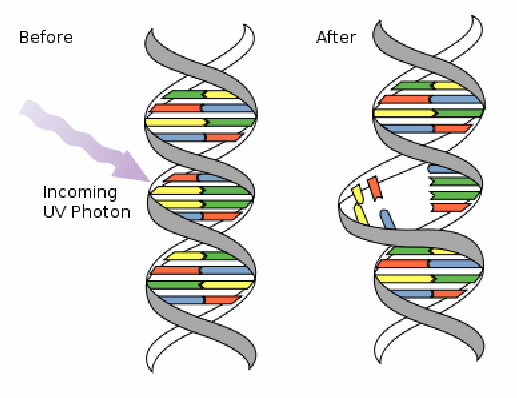Ultraviolet radiation occupies that part of the electromagnetic spectrum with wavelengths between![]() Ultraviolet radiation from the Sun is largely prevented by the atmosphere from reaching the ground. If it were to reach the ground so that people were exposed to it, it may cause premature aging, burning of the skin and possibly cancer. A possible cancer causing mechanism is shown below.
Ultraviolet radiation from the Sun is largely prevented by the atmosphere from reaching the ground. If it were to reach the ground so that people were exposed to it, it may cause premature aging, burning of the skin and possibly cancer. A possible cancer causing mechanism is shown below.
 DNA is made up of strands of bases connected by a ladder of hydrogen bonds. The bonds may be broken by UV rays, and adjacent bases bond with each other, instead of across the “ladder.” The cell will often dies, but may also become cancerous.
DNA is made up of strands of bases connected by a ladder of hydrogen bonds. The bonds may be broken by UV rays, and adjacent bases bond with each other, instead of across the “ladder.” The cell will often dies, but may also become cancerous.
Ultraviolet radiation does not consist of a single type of radiation that has a single effect. There are three distinct types of ultraviolet radiation described by wavelength or effect.
UV – A radiation has wavelengths in the range 400 nm – 315 nm corresponding to energies between 3.10 – 3.94 eV. UV - A radiation penetrates deep into the skin and is responsible for premature aging of the skin and skin cancer. can emit 2 to 5 times more UVA radiation per square metre than the sun.
UV - B radiation has wavelengths in the range 315 nm – 280 nm corresponding to energies between 3.94 – 4.43 eV. It mainly affects the outer layers of the skin, causing sunburns, premature aging and skin cancer. These rays are strongest during the summer months – especially during early afternoon.
UV – C radiation has wavelengths in the range 280 – 100 nm corresponding to energies between 4.43 – 12.4 eV. However, they are stopped by the earth’s atmosphere and do not reach earth’s surface.
